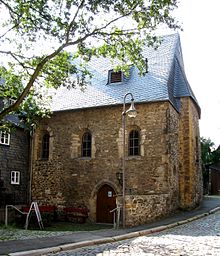Klaus Chapel (Goslar)
The Klaus Chapel in Goslar is a small Romanesque church building from the 12th century. Built as a gate chapel , it has served the miners from Rammelsberg as a place of worship since 1537 . Today the chapel belongs to the Evangelical Lutheran parish of Frankenberg .
history
The earliest mention of the Klaus chapel comes from 1186. It was presumably given to the patronage of St. Nicholas , the patron saint of carters and travelers, because it was located at the southern of the four city gates, the starting point of the Alte Harzstrasse . The gate got its name from the chapel, first mentioned in 1293.
After the Johanneskirche and the associated hospital had been destroyed for strategic reasons in the conflict between the town and Duke Heinrich II of Brunswick in 1527 , the town council made the Klaus chapel available to the miners in 1537. They set up a new hospital in the adjoining buildings for the sick and injured, and for children and old people who were not cared for in their community, and everyone regularly contributed to its maintenance. Festival services for the community, devotions at the start of the shift and exequies were held in the chapel . From 1552 it belonged with the ore mine to the Duchy of Braunschweig-Wolfenbüttel and its legal successors, most recently Preussag , which it sold to the Frankenberg parish in 1969. The building continues to be used for special church services and to maintain the tradition of mining, for example in 1988 after the last shift on the Rammelsberg.
Building
The Klaus Chapel is a rectangular hall church made of stone masonry . The flat-roofed main room measures 10 m × 7 m, the rectangular choir adjoining to the east with groin vault and round apse 4 m × 6 m. The south wall is windowless, it was part of the city wall ; the battlements ran across the attic, recognizable by the walled-in loopholes . Most of the west wall on the street side was also the east wall of the gate tower. The north wall contains the entrance and three Romanesque arched windows. A door now walled up in the north wall of the choir led to the hospital. In the roughly head-high wall that continues the west wall to the north, there are two (poorly preserved) reliefs on the street side, presumably depictions of St. Nicholas.
Furnishing
The Romanesque Altarmensa , a carved crucifix from the 15th century, the Gothic wooden pulpit and remains of Gothic frescoes above have been preserved from the furnishings from before 1537 . During the redesign after 1537, the painted wooden ceiling was created. The lectern dates from the 17th century. The crucifixion group in the choir arch was also put together from older pieces during this period. In 1752 the Gothic bell of the Siechenhof Chapel St. Pankratius came to the Klaus chapel . In 1929 Reinhold Ebeling repainted the chapel; the pantocrator representation in the apse has been preserved. Two candlesticks that were created on the occasion of the thanksgiving ceremony in 1988 are modern; the one, from high-grade ore , is on the altar, the other, from Armerz , in a medieval Erztrage on the floor.
Web links
- The Klaus Chapel (network presence of the parish)
- Klauskapelle (goslar.de)
- Photo documentation (Raymond Faure)
Individual evidence
- ↑ Ev. Kirchengemeinde Frankenberg ( Memento of the original dated December 23, 2015 in the Internet Archive ) Info: The archive link was inserted automatically and has not yet been checked. Please check the original and archive link according to the instructions and then remove this notice.
- ↑ To the bell (inschriften.net)
Coordinates: 51 ° 54 '9.8 " N , 10 ° 25' 18.7" E


